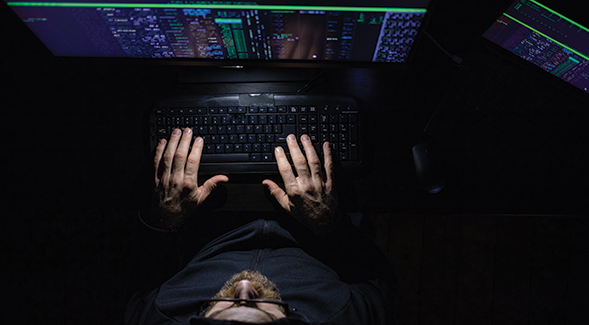SDSU Researchers Working to Protect Power Grids Against Natural Disasters and Cyberattacks
SDSU engineering professors are granted $1.5M to develop technologies to advance the cyber-physical resilience in the carbon-neutral era.

Under a $1.5 million federal grant, San Diego State University researchers are developing ways to protect the current power system from the effects of natural disasters and cyberattacks that leave people and utility companies vulnerable to data breaches and widespread blackouts.
Their work aims to help utilities withstand events that carry the threat of pervasive power outages at a time when energy systems need to be redesigned to accommodate the growing use of renewable energy sources.
Assistant Professor of Electrical and Computer Engineering Tong Huang and Distinguished Professor Chris Mi received a grant from the National Science Foundation (NSF) ASCENT (Addressing Systems Challenges through Engineering Teams) program to further their research.
“Power grid resilience is the backbone of modern society, ensuring that lights stay on, industries thrive and essential services are uninterrupted,” said Mi. “It is an interdisciplinary subject involving math, computer science, power engineering, and artificial intelligence. In a world where the digital and physical realms are increasingly intertwined, empowering the next generation with the tools to protect and adapt is essential for a resilient and secure future of our power grid.”
While incorporating advanced clean technology plays a significant role in transitioning to a carbon-neutral society, current power distribution grids are not prepared to host the growing number of high volumes of new energy resources, such as solar panels, electric vehicles and energy storage structures.
Compounding the challenges, these new resources include cyber layers that are vulnerable to cyberattacks.
Huang will collaborate with Mi and Marija Ilic, a professor of Electrical Engineering and Computer Science (EECS) at Massachusetts Institute of Technology, to address these critical challenges. Huang's team was one of six selected in August for the NSF ASCENT program. The highly selective program was established to support interdisciplinary research in the electrical, communications and cyber systems space to enhance energy security, improve energy efficiency, and combat climate change.

The Project
The four-year project is addressing two of the largest threats to the power grid: cyberattacks and natural disasters.
Their objectives will be achieved by understanding the power grid dynamics from a new lens referred to as “energy space.” In researching energy space, the team is innovating a sensing and control system that will monitor power distribution grids that host energy storage structures, renewables, and electric vehicles.
“Power grid blackouts have occurred as a result of both natural disasters and cyberattacks,” said Mi. “Our project is distinctive in its approach, proactively identifying the sources of both natural disasters and cyberattacks before they can breach the power grid. This proactive identification allows us to swiftly implement mitigation measures, thus preventing power grid blackouts.”
With powerful weather events becoming more frequent due to climate change, the aging electricity infrastructure will remain vulnerable. Throughout their research, the SDSU researchers will test the efficacy of their technology by performing high-stress computer simulations of these threats.
“The U.S. and other countries want to decarbonize their energy systems by including more renewables into the electricity infrastructure,” said Huang. “But, the question is how do we design the electric energy systems such that they can host rich renewables while being more resilient to extreme weather events? This is a grand challenge facing our humanity.”
The sensor technology in their system is tested using a computer simulation that replicates the effects of natural disasters while a high volume of power electronics-interfaced resources (PERs) are connected to the grid. The objective is that even under extreme stress, the system will survive.
The system will also be able to self-detect and mitigate cyberattacks, one of the greatest perils of the power grid. This is done using a dynamic approach similar to the watermark that protects currency from counterfeiting. In this case, a small signal is inserted into the system that will help differentiate attempted cyberattacks from other physical disturbances, thwarting the attack.
Providing a new way to detect cyberattacks, this concept will immensely enhance the grid’s resilience.
Educating The Future
Along with new technology, this project also highlights the demand to rethink how to analyze the dynamics of our electricity infrastructure.
“Once this project succeeds, it will transform the way people analyze and design electric energy systems,” Huang said.
The funding will also allow Huang, Mi and their team of graduate students to launch an annual summer workshop for intermediate and high school students to learn about cybersecurity and renewable energy.
Huang is already weaving cybersecurity and clean energy into his power-system and electric-machine courses at SDSU. He believes that as the world shifts into a carbon-neutral, digitized era, it becomes more and more crucial for next-generation engineers and researchers to begin thinking about the electricity infrastructure from new perspectives.
“This project will provide a transformative way for people to understand the complicated dynamics governing our electric energy systems. Such a way will lead to simple but powerful control designs for the next-generation electric energy systems,” said Huang.



